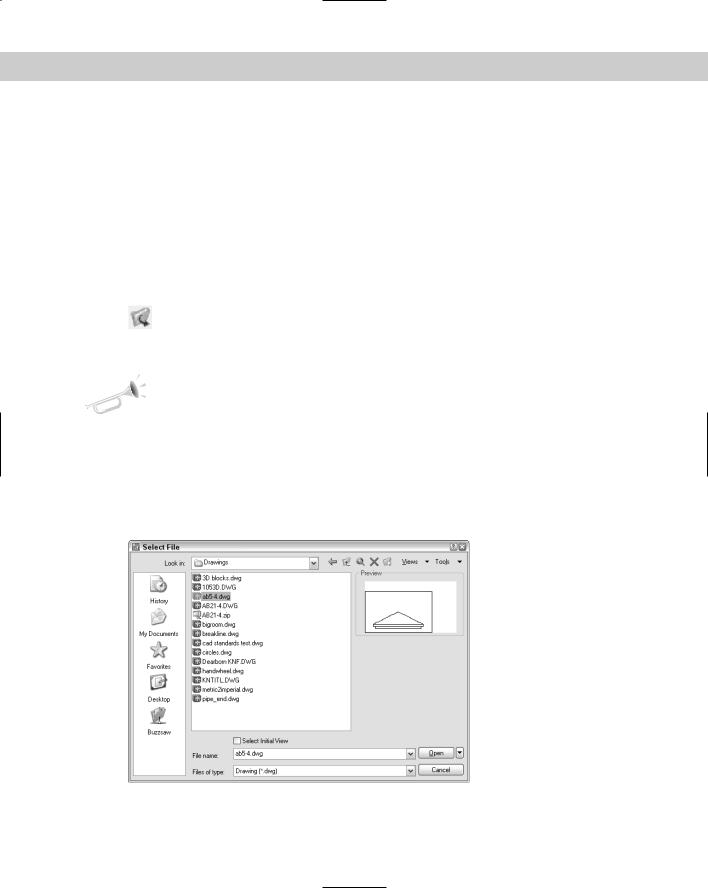
- •Foreword
- •Preface
- •Is This Book for You?
- •How This Book Is Organized
- •How to Use This Book
- •Doing the Exercises
- •Conventions Used in This Book
- •What the Icons Mean
- •About the CD-ROM
- •Other Information
- •Contacting the Author
- •Acknowledgments
- •Contents at a Glance
- •Contents
- •Getting Acquainted with AutoCAD and AutoCAD LT
- •Starting AutoCAD and AutoCAD LT
- •Creating a New Drawing
- •Using the AutoCAD and AutoCAD LT Interface
- •Creating Your First Drawing
- •Saving a Drawing
- •Summary
- •Creating a New Drawing from a Template
- •Working with Templates
- •Opening a Drawing with Default Settings
- •Opening an Existing Drawing
- •Using an Existing Drawing as a Prototype
- •Saving a Drawing Under a New Name
- •Summary
- •The Command Line
- •Command Techniques
- •Of Mice and Pucks
- •Getting Help
- •Summary
- •Typing Coordinates
- •Displaying Coordinates
- •Picking Coordinates on the Screen
- •Locating Points
- •Summary
- •Unit Types
- •Drawing Limits
- •Understanding Scales
- •Inserting a Title Block
- •Common Setup Options
- •The MVSETUP Command
- •Summary
- •Using the LINE Command
- •Drawing Rectangles
- •Drawing Polygons
- •Creating Construction Lines
- •Creating Rays
- •Summary
- •Drawing Circles
- •Drawing Arcs
- •Creating Ellipses and Elliptical Arcs
- •Making Donuts
- •Placing Points
- •Summary
- •Panning
- •The ZOOM Command
- •Aerial View
- •Named Views
- •Tiled Viewports
- •Snap Rotation
- •User Coordinate Systems
- •Isometric Drawing
- •Summary
- •Editing a Drawing
- •Selecting Objects
- •Summary
- •Copying and Moving Objects
- •Using Construction Commands
- •Creating a Revision Cloud
- •Hiding Objects with a Wipeout
- •Double-Clicking to Edit Objects
- •Grips
- •Editing with the Properties Palette
- •Selection Filters
- •Groups
- •Summary
- •Working with Layers
- •Changing Object Color, Linetype, and Lineweight
- •Working with Linetype Scales
- •Importing Layers and Linetypes from Other Drawings
- •Matching Properties
- •Summary
- •Drawing-Level Information
- •Object-Level Information
- •Measurement Commands
- •AutoCAD’s Calculator
- •Summary
- •Creating Single-Line Text
- •Understanding Text Styles
- •Creating Multiline Text
- •Creating Tables
- •Inserting Fields
- •Managing Text
- •Finding Text in Your Drawing
- •Checking Your Spelling
- •Summary
- •Working with Dimensions
- •Drawing Linear Dimensions
- •Drawing Aligned Dimensions
- •Creating Baseline and Continued Dimensions
- •Dimensioning Arcs and Circles
- •Dimensioning Angles
- •Creating Ordinate Dimensions
- •Drawing Leaders
- •Using Quick Dimension
- •Editing Dimensions
- •Summary
- •Understanding Dimension Styles
- •Defining a New Dimension Style
- •Changing Dimension Styles
- •Creating Geometric Tolerances
- •Summary
- •Creating and Editing Polylines
- •Drawing and Editing Splines
- •Creating Regions
- •Creating Boundaries
- •Creating Hatches
- •Creating and Editing Multilines
- •Creating Dlines
- •Using the SKETCH Command
- •Digitizing Drawings with the TABLET Command
- •Summary
- •Preparing a Drawing for Plotting or Printing
- •Creating a Layout in Paper Space
- •Working with Plot Styles
- •Plotting a Drawing
- •Summary
- •Combining Objects into Blocks
- •Inserting Blocks and Files into Drawings
- •Managing Blocks
- •Using Windows Features
- •Working with Attributes
- •Summary
- •Understanding External References
- •Editing an Xref within Your Drawing
- •Controlling Xref Display
- •Managing Xrefs
- •Summary
- •Preparing for Database Connectivity
- •Connecting to Your Database
- •Linking Data to Drawing Objects
- •Creating Labels
- •Querying with the Query Editor
- •Working with Query Files
- •Summary
- •Working with 3D Coordinates
- •Using Elevation and Thickness
- •Working with the User Coordinate System
- •Summary
- •Working with the Standard Viewpoints
- •Using DDVPOINT
- •Working with the Tripod and Compass
- •Getting a Quick Plan View
- •Shading Your Drawing
- •Using 3D Orbit
- •Using Tiled Viewports
- •Defining a Perspective View
- •Laying Out 3D Drawings
- •Summary
- •Drawing Surfaces with 3DFACE
- •Drawing Surfaces with PFACE
- •Creating Polygon Meshes with 3DMESH
- •Drawing Standard 3D Shapes
- •Drawing a Revolved Surface
- •Drawing an Extruded Surface
- •Drawing Ruled Surfaces
- •Drawing Edge Surfaces
- •Summary
- •Drawing Standard Shapes
- •Creating Extruded Solids
- •Drawing Revolved Solids
- •Creating Complex Solids
- •Sectioning and Slicing Solids
- •Using Editing Commands in 3D
- •Editing Solids
- •Listing Solid Properties
- •Summary
- •Understanding Rendering
- •Creating Lights
- •Creating Scenes
- •Working with Materials
- •Using Backgrounds
- •Doing the Final Render
- •Summary
- •Accessing Drawing Components with the DesignCenter
- •Accessing Drawing Content with Tool Palettes
- •Setting Standards for Drawings
- •Organizing Your Drawings
- •Working with Sheet Sets
- •Maintaining Security
- •Keeping Track of Referenced Files
- •Handling Errors and Crashes
- •Managing Drawings from Prior Releases
- •Summary
- •Importing and Exporting Other File Formats
- •Working with Raster Images
- •Pasting, Linking, and Embedding Objects
- •Summary
- •Sending Drawings
- •Opening Drawings from the Web
- •Creating Object Hyperlinks
- •Publishing Drawings
- •Summary
- •Working with Customizable Files
- •Creating Keyboard Shortcuts for Commands
- •Customizing Toolbars
- •Customizing Tool Palettes
- •Summary
- •Creating Macros with Script Files
- •Creating Slide Shows
- •Creating Slide Libraries
- •Summary
- •Creating Linetypes
- •Creating Hatch Patterns
- •Summary
- •Creating Shapes
- •Creating Fonts
- •Summary
- •Working with Menu Files
- •Customizing a Menu
- •Summary
- •Introducing Visual LISP
- •Getting Help in Visual LISP
- •Working with AutoLISP Expressions
- •Using AutoLISP on the Command Line
- •Creating AutoLISP Files
- •Summary
- •Creating Variables
- •Working with AutoCAD Commands
- •Working with Lists
- •Setting Conditions
- •Managing Drawing Objects
- •Getting Input from the User
- •Putting on the Finishing Touches
- •Summary
- •Understanding Local and Global Variables
- •Working with Visual LISP ActiveX Functions
- •Debugging Code
- •Summary
- •Starting to Work with VBA
- •Writing VBA Code
- •Getting User Input
- •Creating Dialog Boxes
- •Modifying Objects
- •Debugging and Trapping Errors
- •Moving to Advanced Programming
- •A Final Word
- •Installing AutoCAD and AutoCAD LT
- •Configuring AutoCAD
- •Starting AutoCAD Your Way
- •Configuring a Plotter
- •System Requirements
- •Using the CD with Microsoft Windows
- •What’s on the CD
- •Troubleshooting
- •Index

Chapter 2 Opening a Drawing |
23 |
Figure 2-2: When you create a drawing based on a template, AutoCAD or AutoCAD LT opens a drawing called Drawing2.dwg.
Working with Templates
A template contains ready-made settings to get you started drawing quickly. These settings include the size of the drawing (called limits), the unit type (such as decimal or feet and inches), and others. An important part of setting standards in an office where people work together on drawings is the creation of a template so that all users work with an identical setup.
Cross- |
In Chapter 5, I explain more of the options available for setting up a drawing. In Chapter 26, |
Reference |
I cover the process of setting standards for drawings. |
|
A template may contain more than just settings — it often contains a complete title block, for example, and may include boilerplate (standardized) text as well.
Customizing the default template
Most people customize the default template to create one or more templates that suit their particular needs. After your templates are created, you don’t have to worry about most settings; they are already available for you and you can quickly start to draw.

24 |
Part I AutoCAD and AutoCAD LT Basics |
To customize acad.dwt or aclt.dwt, follow these steps:
1.Open a drawing based on the template as described in the previous section.
2.Make any changes you want.
3.Click Save on the Standard toolbar.
4.In the Save Drawing As dialog box, click the Files of Type drop-down list box. Choose AutoCAD Drawing Template or AutoCAD LT Drawing Template (*.dwt). In the list of template files, choose the template that you want to customize. Click Save.
5.When asked if you want to replace it, click Yes.
6.In the Template Description dialog box, revise the description as you like and click OK.
Caution |
If you’re using someone else’s computer, don’t change templates that come with AutoCAD |
|
or AutoCAD LT without first checking with the computer’s owner. It can be a frustrating expe- |
|
rience to start a drawing based on a template and find that all the settings have been |
|
changed. Also, if you create new templates, put them in their own folder to avoid losing |
|
them when you upgrade or reinstall AutoCAD. |
Creating your own templates
You may want several templates to choose from on a regular basis. For example, you may create drawings of several sizes. AutoCAD and AutoCAD LT let you create as many templates as you want. To create your own templates, either start a drawing based on a template and make the changes you want, or open an existing drawing that already has some of the settings you want and make any further changes you need. Follow these steps:
1.If you start a new drawing based on a template, choose Save from the Standard toolbar. If you open an existing drawing, choose File Save As from the menu.
2.In the Save Drawing As dialog box, click the Files of Type drop-down list box. Choose AutoCAD Drawing Template or AutoCAD LT Drawing Template.
3.In the File Name text box, type a name for your template. Click Save.
4.In the Template Description dialog box, enter the description as you want. Click OK.
Tip |
Name your templates in a way that clearly differentiates them from regular drawings. You may |
|
want drawings set up for each of the standard paper sizes (A through E), with a title block in |
|
each. Useful names might be tb-a.dwt, tb-b.dwt (tb meaning title block), and so on. |
|
Most AutoCAD and AutoCAD LT users take advantage of these techniques as a standard prac- |
|
tice. You can usually make profitable use of a template as the basis for a new drawing. |
Opening a Drawing with Default Settings
Occasionally, you want to open a drawing without any settings. It is actually impossible for a drawing to have no settings at all, but you can open a drawing with the minimum possible presets. You might want to do this if you’re working on someone else’s computer and don’t want to take the time to get rid of a large number of complex settings that aren’t helpful for your work.

Chapter 2 Opening a Drawing |
25 |
To open a drawing with the fewest possible settings, choose File New. Instead of choosing a template, click the arrow to the right of the Open button (see Figure 2-1). Choose one of the following options:
Open with no template — Imperial
Open with no template — Metric
Opening an Existing Drawing
Often you need to open an existing drawing, either to complete it or to make changes. Opening a drawing in AutoCAD or AutoCAD LT is like opening a file in any Windows program. You can find existing drawings by name or by viewing a thumbnail image of the drawing.
Choose Open from the Standard toolbar. The Select File dialog box appears, as shown in Figure 2-3. In the Look In drop-down list box, choose the drive where your drawing resides. In the main box, double-click the folder you need. Then choose your drawing. The Preview box enables you to quickly look at the drawing to see if it’s the one you want. Click
Open. The drawing opens.
New |
If you open more than one drawing, each drawing has its own button on the Windows |
Feature |
taskbar. (You can still switch between drawings using the Window menu.) If you want to turn |
|
|
|
off this feature, type taskbar on the command line and press Enter. At the Enter new |
|
value for TaskBar <1>: prompt, type 0 and press Enter. |
If you have Windows 2000 or XP, you can view thumbnail images of all the drawings in a folder in the Select File dialog box (and other dialog boxes that enable you to choose a file) by clicking the Views button and choosing Thumbnails. In all operating systems, you can view thumbnails in Windows Explorer in the same way — by clicking the Views button and choosing Thumbnails.
Figure 2-3: The Select File dialog box is equivalent to the Open dialog box in most Windows programs.

26 |
Part I AutoCAD and AutoCAD LT Basics |
To look for a file to open on the Web, click the Search the Web button in the dialog box. You can also use the Places list at the left side of the dialog box to find drawings. The
Places list is described in Chapter 1.
You can double-click a drawing in Windows Explorer to open it. If AutoCAD or AutoCAD LT is not running, Windows loads the program and the drawing as well. If AutoCAD or AutoCAD LT is running and a drawing is active, the drawing opens as a second drawing within the program.
You can also open a drawing from the DesignCenter — a feature for managing both drawing files and many of their components. First, choose DesignCenter from the Standard
toolbar. The DesignCenter palette opens, displaying an Explorer-like list of drawings in the left pane. If necessary, choose Desktop from the DesignCenter toolbar. Navigate to the folder containing the drawing and choose the drawing’s folder in the left pane. The drawings in the folder are listed in the right pane. Right-click the drawing of your choice and choose Open in Application Window. For more information on the DesignCenter, see Chapter 26.
You can open a drawing using the new Sheet Set Manager (AutoCAD only). I cover sheet sets in Chapter 26.
You can use several shortcuts when working in dialog boxes that open or save files, as follows:
On the
CD-ROM
Double-click the drawing file to open it immediately without clicking Open.
Click the Views drop-down list. Choose List to see a simple list. Choose Details to see the file size and the last date and time the file was saved.
Right-click inside the dialog box to open a shortcut menu with more options.
Click the name of a drawing to highlight it and then click it once more to rename it (but don’t double-click it — that opens the drawing).
The drawing used in the following Step-by-Step exercise on opening a drawing, ab01-01. dwg, is in the Results folder of the AutoCAD 2005 and AutoCAD LT 2005 Bible CD-ROM. Place the CD-ROM in your CD-ROM drive.
STEP-BY-STEP: Opening a Drawing
1.If AutoCAD or AutoCAD LT is not open, start the program.
2. Click Open on the Standard toolbar.
Click Open on the Standard toolbar.
3.In the Select File dialog box, choose the drive for your CD-ROM in the Look In drop-down list box.
4.In the main box, double-click the Results folder.
5.In the main box, click ab01-01.dwg.
6.Click Open. The drawing opens. Keep this drawing open for the next exercise.
Using an Existing Drawing as a Prototype
Although a template can be very useful, if you plan to use the objects and settings in a drawing only a few times, you can simply use one drawing as a prototype for other drawings. You often need to draw a series of related drawings — perhaps several related electrical schematics or a
